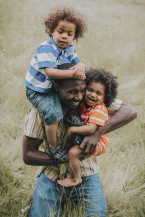Connecting with Compassion

The Predicament of Our Lives: Why We Don’t Always Help
Have you ever found yourself in a situation where you could help someone, but you didn’t? Perhaps you were too preoccupied with your own thoughts or in a hurry to get somewhere. A study at the Princeton Theological Seminary showed that even when people were thinking the parable of the Good Samaritan, they didn’t always stop to help someone in need. The determining factor was how much of a hurry they thought they were in or how absorbed they were in their thoughts.
It turns out that our default wiring is to help others. Social neuroscience has shown that when we attend to another person, we automatically empathize and feel with them. Mirror neurons in our brain activate in the same areas as the other person’s, creating a neuro Wi-Fi that allows us to feel “with” them. But despite this, we don’t always help others.
The difference lies in our focus. When we are focused on ourselves, we tend to ignore the needs of others. It can be a very subtle difference, as I discovered when doing my taxes. I realized that I was feeling good about myself for donating to a charity and that I was getting a narcissistic hit from it. But then I thought about the people who would benefit from my donation, and my focus shifted from myself to them.
This distinction between self-focus and other-focus is crucial. It can be seen even in something as seemingly trivial as speed dating. One woman I overheard at a sushi restaurant explained why her brother was having trouble getting dates. He never asked about the woman; he only talked about himself. On the other hand, Alice Charney Epstein had a simple test for potential partners: how long would it take them to ask her a question with the word “you” in it?
The Harvard Business Review has a term for the act of fully focusing on another person: the human moment. It means turning off your distractions and paying full attention to the person in front of you. It’s a simple act of noticing, and it can make all the difference.
Compassionate consumerism is another area where we can make a difference by focusing on others. We often don’t think about the consequences of the things we buy and use. But with new electronic tagging technology, we can track an item’s history all the way back to the factory. We can make informed choices about the products we buy, choosing the virtuous ones over the non-virtuous.
Ultimately, the power of noticing is what separates us from those who lack empathy. We can choose to focus on ourselves or on others. We can choose to notice or to ignore. It’s a choice we make every day, and it’s a choice that can make a real difference in the world.
Social Neuroscience and the Default Wiring to Help Others
Have you ever wondered why some people are more inclined to help others while others seem indifferent? A relatively new field in brain science, called social neuroscience, studies the circuitry in two people’s brains that activates while they interact. According to this field, our default wiring is to help, meaning that if we attend to the other person, we automatically empathize and feel with them.
Social neuroscientists have identified newly identified neurons called mirror neurons that act like a neuro Wi-Fi, activating in our brain exactly the areas activated in theirs. This means that we feel “with” others automatically. And if that person is in need or suffering, we’re automatically prepared to help. At least that’s the argument.
However, the question still remains: why don’t we help others more often? The answer lies in the difference between focusing on ourselves and focusing on others. If we’re preoccupied with our own thoughts and concerns, we’re less likely to notice others who need our help. This difference can be subtle but significant.
The speaker in the original video provides an example of how he became more altruistic in his actions. He was doing his taxes and realized that he felt good about himself when he made a donation to a charity. However, he then realized that his motivation was more self-focused than altruistic. When he shifted his focus to the people in need, he experienced a sense of altruistic joy that motivated him to help even more.
In conclusion, social neuroscience shows us that our brains are wired to help others. However, we need to pay attention to our focus and shift it towards others to fully activate our empathetic responses. By doing so, we can help create a more compassionate society where people are more inclined to help each other.
Self-Absorption vs. Empathy and Compassion
The distinction between focusing on oneself and focusing on others is one that we should all pay attention to. When we’re focused on ourselves, we turn off that part of us that tunes into others, and we miss opportunities to help. Even subtle differences between self and other focus can make a significant impact. For instance, while doing taxes, I realized that I was giving to charity because it made me feel good about myself, rather than to help those in need. It was only when I started thinking about the people being helped that I felt altruistic joy.
Interestingly, studies have shown that our default wiring is to help others. If we attend to another person, we automatically empathize and feel with them. Social neuroscience has identified neurons called mirror neurons that act like a neuro Wi-Fi, activating in our brains the same areas that are activated in others’ brains. We feel with others automatically, and if that person is in need, we’re prepared to help.
But why don’t we always help? The answer lies in the spectrum that goes from complete self-absorption to noticing, empathy, and compassion. When we’re focused on ourselves, we miss opportunities to help, no matter how compassionate we may be. We need to pay attention to the other person and turn off distractions. It’s our empathy and our ability to tune in that separates us from Machiavellians or sociopaths.
How Focusing on Ourselves can Interfere with Altruistic Joy
In a world where we are often preoccupied with ourselves, it can be easy to lose sight of others and their needs. This is especially true when it comes to acts of kindness and altruism. As the speaker highlighted in their TED Talk, even seemingly selfless acts can be tainted by a desire for personal gain or recognition.
The speaker describes a moment while doing their taxes where they realized that their motivation for giving to a charity was not entirely altruistic. They felt a sense of pride and self-importance for their charitable donation, which they recognized was a form of narcissism. But then, as they reflected on the people who would benefit from their donation, they shifted from a focus on themselves to a focus on others.
This shift is what the speaker calls “altruistic joy.” It is the feeling of joy that comes from helping others without any expectation of reward or recognition. However, this joy can be difficult to experience if our focus is solely on ourselves. When we are self-absorbed, we don’t fully notice the needs of others and may miss opportunities to help.
The speaker encourages us to pay attention to this distinction between focusing on ourselves and focusing on others. By doing so, we can become more aware of our motivations for helping and make a conscious effort to shift our focus towards others. In doing so, we can experience the true joy of altruism and make a meaningful difference in the lives of those around us.
The Importance of Focusing on Others in Dating and Beyond
When it comes to dating and relationships, it can be easy to become fixated on our own needs and desires. We might spend a lot of time thinking about what we want in a partner, or worrying about how we appear to others. But according to social psychology research, this self-focus can actually backfire.
When we are too focused on ourselves, we may miss important cues from others and fail to connect with them on a deeper level. This can prevent us from forming meaningful relationships and experiencing the joy of giving to others.
Research shows that focusing on others, on the other hand, can lead to greater happiness and fulfillment in life. When we shift our attention away from ourselves and towards the needs and desires of others, we are more likely to feel a sense of purpose and meaning. In the context of relationships, this can mean being more attentive to our partner’s needs and desires, and working to build a strong, mutual connection.
Of course, this doesn’t mean that we should neglect our own needs entirely. It’s important to take care of ourselves and make sure that our own needs are being met. But by focusing more on others and less on ourselves, we can grow greater empathy and compassion, which can in turn lead to deeper, more fulfilling relationships.
The Human Moment: Making Real Contact with Others
In our busy lives, we often forget the importance of human connection. We go through the motions of our day-to-day routines, barely acknowledging the people we encounter along the way. However, making real contact with others can be incredibly powerful and fulfilling.
When we have a genuine interaction with someone, we feel seen and heard, and we have the opportunity to see and hear them as well. This kind of connection can make us feel less alone in the world and more connected to something greater than ourselves.
Unfortunately, many of us have become so consumed with technology that we have forgotten how to make meaningful connections with others. We may feel as though we are constantly “connected” through social media or other online platforms, but these connections can often feel shallow and unfulfilling.
So, how can we make real contact with others? It starts with being present in the moment and truly listening to the people around us. It means putting away our phones and other distractions and giving our full attention to the person in front of us.
It also means being vulnerable and open with others, sharing our thoughts and feelings honestly and authentically. When we allow ourselves to be vulnerable, we give others permission to do the same, and this can lead to deep and meaningful connections.
In summary, taking the time to make real contact with others can be incredibly powerful and fulfilling. It allows us to feel seen and heard, and to see and hear others as well. By being present, listening, and being vulnerable, we can create connections that go beyond the surface and touch us at our very core.
The Connection Between Empathy and Compassionate Consumerism
Empathy is the ability to understand and share the feelings of others. Compassionate consumerism is the practice of using our purchasing power to support ethical and sustainable businesses. At first glance, these two concepts may seem unrelated, but in reality, they are deeply interconnected.
Empathy allows us to see the world through the eyes of others, to understand the impact our actions have on them, and to feel motivated to make a difference. When we extend this empathy to the products we buy, we become more conscious of the impact our purchases have on the environment, the workers who make them, and the communities they come from.
Compassionate consumerism takes this one step further by actively seeking out products that align with our values and supporting businesses that prioritize ethical and sustainable practices. By doing so, we create a demand for products that are made with care and consideration for people and the planet.
Empathy and compassionate consumerism work together to create a positive feedback loop. When we buy from ethical and sustainable businesses, we support their mission and encourage others to do the same. This, in turn, helps to shift the larger market towards more responsible and conscientious practices.
So, the next time you’re shopping, take a moment to consider the impact your choices have on others. Choose products that align with your values and support businesses that prioritize ethical and sustainable practices. By doing so, you can make a difference in the world and contribute to a more compassionate and empathetic society.
Noticing and Making a Difference: The Power of Compassion
Compassion is a powerful force that can make a significant difference in people’s lives. It is the ability to notice suffering in others and take action to ease that suffering. When we practice compassion, we connect with others on a deeper level, and we become more aware of the world around us.
Compassion involves paying attention to the feelings and needs of others, not just our own. It requires empathy and a willingness to take action to help those in need. We can show compassion in small ways, such as holding the door open for someone or offering a kind word to a stranger. These small acts of kindness can have a significant impact on someone’s day.
At times, it can be challenging to practice compassion, especially when we are busy or stressed. We may overlook opportunities to help others because we are too focused on our own problems. However, when we make an effort to notice and respond to the needs of others, we can create a ripple effect of kindness that can spread throughout our community.
Compassion is not just about making others feel better; it also has benefits for ourselves. Studies have shown that practicing compassion can reduce stress, increase feelings of happiness and well-being, and improve our relationships with others. When we show compassion, we become more connected to others, which can lead to a greater sense of purpose and fulfillment in our lives.
In conclusion, compassion is a powerful tool that can make a positive difference in the world. By noticing the suffering of others and taking action to help, we can create a more kind and compassionate society. So let us practice compassion in our daily lives and make a difference, one small act of kindness at a time.
Conclusion
In conclusion, compassion and empathy are essential traits that contribute to our overall well-being and the well-being of others. It is important to grow these qualities by practicing self-awareness, actively listening to others, and engaging in acts of kindness and altruism.
We learned that our brain is wired for social connection and helping others, but sometimes our self-absorption and narcissism can interfere with our ability to experience altruistic joy. By shifting our focus to others, we can create meaningful connections and experience the satisfaction of making a positive impact on someone else’s life.
In today’s fast-paced and individualistic world, it is easy to get caught up in our own problems and forget the power of human connection. By slowing down and noticing the opportunities to make a difference, we can create a ripple effect of kindness and compassion that can spread to those around us.
Let us strive to be more compassionate and empathetic in our daily lives, both in our personal relationships and in the way we interact with the world. Together, we can make a positive impact on the world and create a more connected and empathetic society.
















